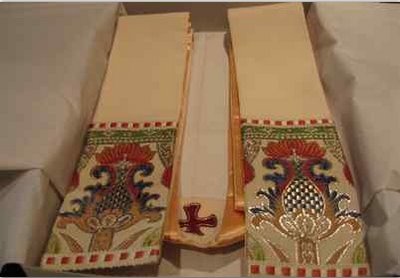Spanning the globe. Bringing Anglicans and friends of Anglicanism together.
Tuesday, August 2, 2011
Stole
STOLE. A long strip of black or coloured silk, expanded at the ends, worn by priests of the Church of Rome, the ends often being embroidered. It is worn round the neck, and hangs down on either side in front. Its original shape and use were, however, different (Rock’s Hierurgia, p. 429). The colour of the stole is by Romanists and Ritualists often changed according to the festival or fast that is being observed. The important point to be noted is that the stole is entirely distinct from the scarf worn in accordance with continuous usage and custom by the Anglican clergy, and which ought not to be termed a “stole.” The scarf was called also the “tippet.” The scarf consists of a wider strip of folded black silk, and ought to reach down nearly to the ankles. The “tippet” is permitted to be worn by the 58th Canon of 1604, and must not be confused with the hood. The tippet was the distinctive badge of Reformed ministers, opposed to the stole, although both were objected to by the Puritans. Being one of the mass vestments, the stole was discarded in 1549, and Sir R. Philimore, Dean of the Arches, pronounced it illegal on that ground (Hebbert v. Purchas). In the Roman Pontifical, in the form of degrading a priest, the stole is taken away with the words “inhabilem (te) reddimus ad omne sacerdotale officium.” Hoods and tippets are both prescribed for
graduates by Canon 74. The 4th Canon of the Church of Ireland correctly speaks of “the customary scarf of plain black” and as worn with the hood. The “stole” is generally explained in Roman Catholic manuals as representing the cord by which Christ was led along to be crucified. See Wright’s Service of the Mass in the Greek and Roman Churches, p. 43. [C. H. H. Wright]
Subscribe to:
Post Comments (Atom)

No comments:
Post a Comment